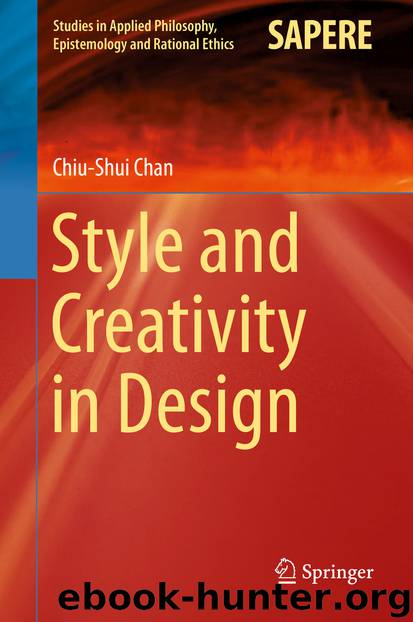Style and Creativity in Design by Chiu-Shui Chan

Author:Chiu-Shui Chan
Language: eng
Format: epub
Publisher: Springer International Publishing, Cham
5.2 Style Created in the Design Processes
When exploring style from the information processing point of view, it is necessary to discover how an individual style is generated from a series of design processes. A design process is defined as a sequence of states for achieving a goal. A process may create new processes, it may share some information with others, and it may allocate some of its information to others for operation as well. An architectural design consists of a number of such design processes, which are the procedures for handling information in the designer’s mind.
Apart from any doctrine, style is operationally defined here as “any distinctive and recognizable way of design that is repeatedly manipulated in design processes and, thus, generates certain common features across design products.” In this regard, a style is argued to be represented by some features in a product that result from certain mental activities. A work of art is not a natural product, but a thing brought into being by human activity, created by the mind. These mental activities can be an individual or group effort. Coming from an individual effort, it is termed individual style. For an individual style, distinctive features in a design work enable observers to visually link a design work with other works by the same architect or with other works by a different architect.
Regardless of whether style is generated from single or group efforts, mental activities and design decisions are practically operated in the design process. Thus, the study of style should ultimately concentrate on the investigations of the cognitive activities utilized in the design process. This content, however, differs from the cognitive style that refers to the characteristic ways in which individuals conceptually organize the environment (Goldstein and Blackman 1978) or the consistent patterns of organizing and processing information (Messick 1976). The differences are that the cognitive style emphasizes the cognitive structure—how cognition is organized—rather than the content of thought—which knowledge is available (Suedfeld 1971); whereas individual style in this chapter refers to the style expressed in art works, including architectural design.
Therefore, there are two groups of components involved in the overall definition of style defined in this chapter—the common features present in the design products, and the procedures and factors that repeatedly operate in the design processes to generate common features. The first component has been explained previously, whereas the second component of the definition refers to certain elements that can be observed and recognized in a number of design processes executed by the same designer. These elements include executing some fixed sequences of procedures in solving a design problem, using the same set of design constraints, and using certain geometric forms. Two examples are used to verify these notions. Frank Lloyd Wright’s Prairie House Style is the first one representing a strong style covered in this chapter. The second example is a weak style of a practicing architect studied from the perspective of design cognition analyzed in Chap. 6. The term weak style relates to the quantification of style but not qualification.
Download
This site does not store any files on its server. We only index and link to content provided by other sites. Please contact the content providers to delete copyright contents if any and email us, we'll remove relevant links or contents immediately.
Kathy Andrews Collection by Kathy Andrews(11768)
The remains of the day by Kazuo Ishiguro(8897)
Spare by Prince Harry The Duke of Sussex(5143)
Paper Towns by Green John(5142)
The Body: A Guide for Occupants by Bill Bryson(5035)
Industrial Automation from Scratch: A hands-on guide to using sensors, actuators, PLCs, HMIs, and SCADA to automate industrial processes by Olushola Akande(5027)
Machine Learning at Scale with H2O by Gregory Keys | David Whiting(4263)
Be in a Treehouse by Pete Nelson(4002)
Never by Ken Follett(3887)
Harry Potter and the Goblet Of Fire by J.K. Rowling(3810)
Goodbye Paradise(3772)
Into Thin Air by Jon Krakauer(3350)
The Remains of the Day by Kazuo Ishiguro(3349)
Fairy Tale by Stephen King(3313)
The Cellar by Natasha Preston(3299)
The Genius of Japanese Carpentry by Azby Brown(3256)
120 Days of Sodom by Marquis de Sade(3229)
The Man Who Died Twice by Richard Osman(3043)
Drawing Shortcuts: Developing Quick Drawing Skills Using Today's Technology by Leggitt Jim(3040)
